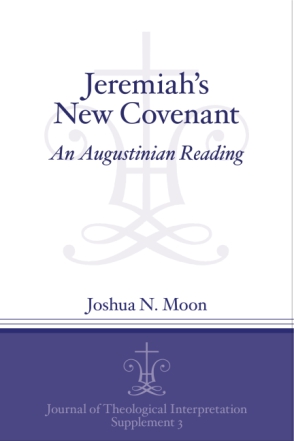Jeremiah's New Covenant
An Augustinian Reading
Joshua N. Moon
The struggle to read Jeremiah 31:31–34 as Christian Scripture has a long and divided history, cutting across nearly every major locus of Christian theology. Yet little has been done either to examine closely the varieties of interpretation in the Christian tradition from the post-Nicene period to the modern era, or to make use of such interpretations as helpful interlocutors. This work begins with Augustine’s interpretation of Jer 31:31–34 as an absolute contrast between unbelief and faith, rather than the now-standard reading (found in Jerome) of a contrast between two successive religio-historical eras—one that governed Israel (the “old covenant”) and a new era and its covenant inaugurated in the coming of Christ. Augustine’s absolute contrast loosened the strict temporal concern, so that the faithful of any era were members of the “new covenant.” The study traces Augustine’s reading of an absolute contrast in a few key moments of Christian interpretation: Thomas Aquinas and high medieval theology, then the 16th and 17th century Reformed tradition. The thesis aims at a constructive reading of Jer 31:31–34, and so the struggle identified in these moments in the Christian tradition is brought into dialogue with modern critical discussions from Bernhard Duhm to the present. Finally, the author turns to an exegetical argument for an ‘Augustinian’ reading of the contrast of the covenants.
- Description
- Table of Contents
Acknowledgments
I. Introduction
1. The ‘Augustinian’ Contrast
2. The ‘New Covenant’: A First Approximation
II. Jeremiah’s New Covenant in Jerome and Augustine
1. Jerome and the New Covenant
2. Augustine and the New Covenant as Mutatio Sacramentorum
3. Augustine and the ‘Salvific’ Contrast
4. Conclusions
III. Jeremiah’s New Covenant in High Medieval Theology
1. Thomas and the Mutatio Sacramentorum
2. Locating the Discussion in the Summa
3. ‘Law’ in Thomas: Natural, Human, and Divine
4. The ‘New Law’ in Thomas
5. Elsewhere in the High Medieval Tradition
6. Conclusions
IV. The Early Modern Reformed Tradition
1. An Augustinian Start: Philip Melanchthon
2. A Contrast of Accidents: Heinrich Bullinger
3. From Complexity to Simplicity: Oecolampadius
4. Augustinian Remnants (a): John Calvin
5. Augustinian Remnants (b): Peter Martyr Vermigli
6. Conclusions
Vth Century Reformed: The Continued Struggle
1. Caspar Olevianus
2. John Ball
3. Herman Witsius
4. Widening the Struggle
5. Conclusions
VI. The New Covenant in Modern Discourse
1. Bernard Duhm
2. The New Covenant in the Life Experience of the Prophet
3. The New Covenant in the Prophetic Traditions
4. The New Covenant and the Deuteronomists
5. A Renewed Covenant?
6. An Augustinian Heritage
7. Conclusions
VII. The Context of the New Covenant
1. The Oracle in the Book
2. The Broken Covenant
a. Jer 11:1-13
b. Jer 7:21-28
3. The Oracles of Restoration: chs-31
a. Jer 30:12-17
b. Jer 30:4-11
c. Jer 30:18-22
d. Jer 31
e. The Wider Book
4. Conclusions
VIII. Jeremiah’s New Covenant: Restitutio ad Integrum
1. The Broken Covenant: 31:31-32
2. The ‘New’ Covenant: 31:33-34
3. Conclusions
IX. Conclusions and Theological Directions
1. Unity of the Covenant
a. The New and Eternal Covenant (of Grace)
b. Qumran and the New Covenant
c. The Climax of the Covenant
2. Unity of the People of God
Works Cited
Indexes
Mailing List
Subscribe to our mailing list and be notified about new titles, journals and catalogs.




